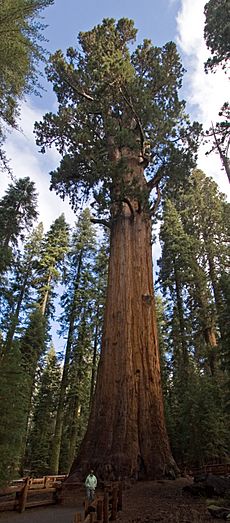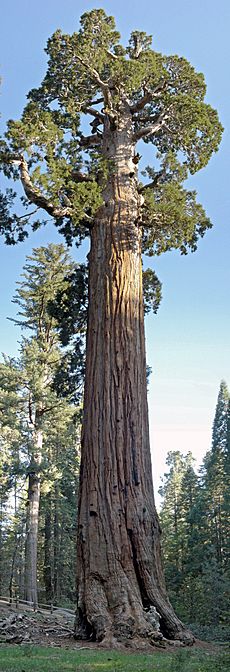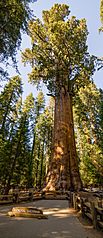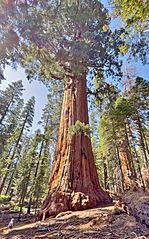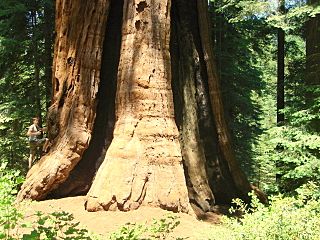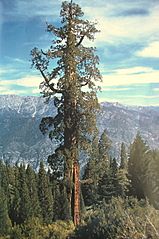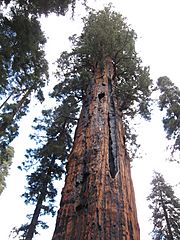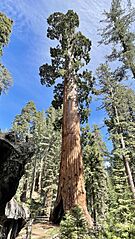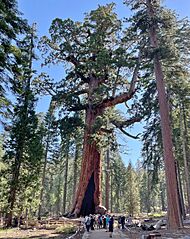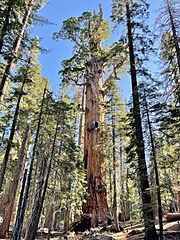List of largest giant sequoias facts for kids
The giant sequoia (Sequoiadendron giganteum) is the world's biggest tree by total volume. It's often called the largest living thing on Earth! While it's not the tallest tree (that's the coast redwood), or the widest (like the African baobab), or the oldest (the Great Basin bristlecone pine lives longer), giant sequoias are still super impressive.
These amazing trees can grow over 87 meters (286 ft) tall. That's taller than a 26-story building! Their base can be wider than a city street, with a circumference of 34 meters (113 ft) or more. Some have lived for over 3,200 years. Each year, a giant sequoia can add about 1.1 cubic meters (40 cu ft) of wood. This is like growing a new 50-foot-tall tree that's one foot wide every year! This makes them one of the fastest-growing living things on Earth in terms of how much they grow in size each year.
Contents
Where Do Giant Sequoias Grow?
Giant sequoias only grow naturally in one special place. This is on the western side of the Sierra Nevada mountains in California. You can find them on moist, ice-free ridges and in valleys. They grow at high elevations, from 1,500 to 2,400 meters (5,000 to 8,000 ft) above sea level.
There are about 65 to 75 groups of giant sequoias, called groves, in the Sierra Nevada. The most northern grove is Placer County Big Trees Grove. The most southern one is Deer Creek Grove. All these groves together cover an area of about 14,400 hectares (35,600 acres).
How Forest Fires Affect Giant Sequoias
Giant sequoias are very special because they are built to handle forest fires. Their bark is extremely thick and can resist fire. Also, their cones usually open up right after a fire, releasing seeds to help new trees grow.
However, fires can also be very dangerous for these trees. Young sequoias are easily hurt or killed by fire. Older, larger trees are tougher because of their thick, fire-resistant bark and high branches. But many fires over hundreds of years can burn through the bark. This can damage the inner layers of the tree.
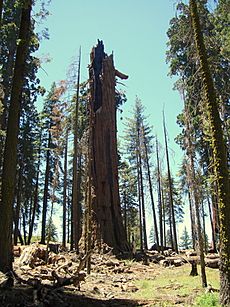
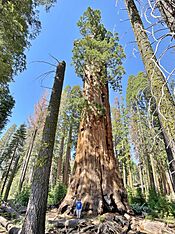
Most large sequoias have scars from past fires, often at their base. Fires rarely kill old trees directly. But the damage can make the tree weaker. Fire scars also allow fungi to get inside, causing root disease and heart rot. This makes the wood inside decay, which can then burn more easily in future fires. This cycle weakens the tree, sometimes causing it to fall over.
Fire damage is also a main reason why the tops of some giant sequoias die. While lightning strikes don't usually kill mature trees, they can break off large parts of the top or set dead branches on fire. The most common way old giant sequoias die is by falling over. This happens when their roots and lower trunk become weak from fire and decay. These trees are incredibly heavy, and their roots don't go very deep, which also makes them more likely to fall. Strong winds, soft soil from water, and heavy snow on their branches can also cause them to topple.
A famous example is the Washington tree in Giant Forest Grove. This tree was the second-largest in the world. But in 2003, a lightning strike caused a fire that made it lose part of its top. Its height dropped from about 78 meters (255 ft) to 70 meters (229 ft). Then, in 2005, heavy snow caused the weakened tree to collapse even more. Now, it's only about 35 meters (115 ft) tall.
How Scientists Measure Giant Sequoias
Measuring giant sequoias is a special job. Scientists use methods called dendrometric techniques. They often measure the tree's height, how wide its branches spread, and its diameter at breast height (DBH). This is the distance around the trunk at chest height.
These measurements help scientists estimate how much wood is in a tree. It's like trying to figure out the volume of a giant, uneven cone. It can be tricky because trees aren't perfectly shaped. Scientists measure the distance around the trunk at a few different heights. They assume the trunk is round and that it tapers evenly between these points.
They only measure the wood in the main trunk, even if there are fire scars. They don't count the wood in the branches or roots. Also, they don't count any hollow spaces inside the tree. For example, in 1999, scientists found that the Washington tree in Giant Forest Grove was mostly hollow inside!
List of the Largest Giant Sequoias by Trunk Volume
The table below shows some of the largest giant sequoias. All of them are found in California. The trees are listed by the amount of wood in their main trunk, not including branches.
means the tree was badly damaged by fire after its last measurement.
| Rank | Name | Location | Coordinates | Height | Circumference | Bole Volume |
Comments | Ref |
|---|---|---|---|---|---|---|---|---|
| 1 | General Sherman | Giant Forest Grove | 36°34′51″N 118°45′03″W / 36.58083°N 118.75083°W | 83.8 m (274.9 ft) | 31.3 m (102.6 ft) | 1,486.9 m3 (52,508 cu ft) | Named after William Tecumseh Sherman. | |
| 2 | General Grant | General Grant Grove | 36°44′53″N 118°58′15″W / 36.74806°N 118.97083°W | 81.7 m (268.1 ft) | 32.8 m (107.5 ft) | 1,319.8 m3 (46,608 cu ft) | Named after Ulysses S. Grant; called the "Nation's Christmas Tree" since 1926. | |
| 3 | President | Giant Forest Grove | 36°34′24″N 118°45′00″W / 36.57341°N 118.75010°W | 73.4 m (240.9 ft) | 28.3 m (93.0 ft) | 1,278.4 m3 (45,148 cu ft) | Named after U.S. President Warren G. Harding. | |
| 4 | Lincoln | Giant Forest Grove | 36°34′19″N 118°45′22″W / 36.57187°N 118.75604°W | 78.0 m (255.8 ft) | 30.0 m (98.3 ft) | 1,259.3 m3 (44,471 cu ft) | Named after Abraham Lincoln. | |
| 5 | Stagg | Alder Creek Grove | 36°11′29″N 118°37′08″W / 36.19131°N 118.61878°W | 74.1 m (243.0 ft) | 33.2 m (109.0 ft) | 1,205.1 m3 (42,557 cu ft) | Named after Amos Alonzo Stagg. | |
| 6 | Boole | Converse Basin Grove | 36°49′26″N 118°56′57″W / 36.82389°N 118.94917°W | 81.9 m (268.8 ft) | 34.4 m (113.0 ft) | 1,202.7 m3 (42,472 cu ft) | Named after Franklin A. Boole. This tree has the largest base of any living giant sequoia. | |
| 7 | Genesis | Mountain Home Grove | 36°12′54″N 118°40′10″W / 36.215119°N 118.669395°W | 77.1 m (253.0 ft) | 26.0 m (85.3 ft) | 1,186.4 m3 (41,897 cu ft) | Named after Genesis. It was badly damaged by the Castle Fire. | |
| 8 | Franklin | Giant Forest Grove | 36°34′04″N 118°45′31″W / 36.56771°N 118.75864°W | 68.2 m (223.8 ft) | 28.9 m (94.8 ft) | 1,169 m3 (41,280 cu ft) | Named after Benjamin Franklin. Located near Washington. | |
| 9 | King Arthur | Garfield Grove | 36°19′42″N 118°43′01″W / 36.32838°N 118.71703°W | 82.4 m (270.3 ft) | 31.8 m (104.2 ft) | 1,151.2 m3 (40,656 cu ft) | Named after King Arthur. It was destroyed in the Castle Fire. | |
| 10 | Monroe | Giant Forest Grove | 36°33′26″N 118°46′10″W / 36.55710°N 118.76939°W | 75.5 m (247.8 ft) | 27.8 m (91.3 ft) | 1,135.6 m3 (40,104 cu ft) | Named after James Monroe, located near Auto Log. | |
| 11 | Robert E. Lee | General Grant Grove | 36°44′53″N 118°58′16″W / 36.7480°N 118.9711°W | 77.6 m (254.7 ft) | 26.9 m (88.3 ft) | 1,135.6 m3 (40,102 cu ft) | Named after Robert E. Lee. | |
| 12 | Floyd Otter | Garfield Grove | 36°19′39″N 118°43′01″W / 36.32748°N 118.71696°W | 83.2 m (273.1 ft) | 30.3 m (99.5 ft) | 1,120.3 m3 (39,562 cu ft) | Named after Floyd Otter, a former manager of the Mountain Home Demonstration State Forest. It might have been heavily damaged by the Castle Fire. | |
| 13 | John Adams | Giant Forest Grove | 76.4 m (250.6 ft) | 25.4 m (83.3 ft) | 1,103.1 m3 (38,956 cu ft) | Named after John Adams, located near Cattle Cabin. | ||
| 14 | Ishi Giant | Kennedy Grove | 36°45′41″N 118°48′38″W / 36.76143°N 118.81062°W | 75.6 m (248.1 ft) | 32.0 m (105.1 ft) | 1,080.5 m3 (38,156 cu ft) | Lost a lot of its trunk and over 8 m (26 ft) in height during the 2015 Rough Fire. New measurements are needed to know its current size. | |
| 15 | Column | Giant Forest Grove | 74.3 m (243.8 ft) | 28.3 m (93.0 ft) | 1,056.1 m3 (37,295 cu ft) | Located near Pershing. | ||
| 16 | Summit Road | Mountain Home Grove | 36°13′41″N 118°40′16″W / 36.22813°N 118.67117°W | 74.4 m (244.0 ft) | 25.1 m (82.2 ft) | 1,040 m3 (36,600 cu ft) | Named after a nearby road. It might have been heavily damaged by the Castle Fire. | |
| 17 | Euclid | Mountain Home Grove | 36°13′46″N 118°40′40″W / 36.22949°N 118.67776°W | 83.1 m (272.7 ft) | 25.4 m (83.4 ft) | 1,022.9 m3 (36,122 cu ft) | Named after Euclid. | |
| 18 | Washington | Mariposa Grove | 37°30′54″N 119°35′53″W / 37.51507°N 119.59806°W | 71.9 m (236.0 ft) | 29.2 m (95.7 ft) | 1,016.6 m3 (35,901 cu ft) | The largest giant sequoia north of Boole. Named after George Washington. Not the same as the Washington tree in Giant Forest Grove. | |
| 19 | Pershing | Giant Forest Grove | 36°34′43″N 118°45′12″W / 36.57869°N 118.75347°W | 75.0 m (246.0 ft) | 27.8 m (91.2 ft) | 1,015.3 m3 (35,855 cu ft) | Named after John J. Pershing. | |
| 20 | Diamond | Atwell Mill Grove | 36°27′48″N 118°41′51″W / 36.46343°N 118.69740°W | 87.2 m (286.0 ft) | 29.0 m (95.3 ft) | 999.4 m3 (35,292 cu ft) | Named for a large diamond-shaped scar on its trunk. | |
| 21 | Adam | Mountain Home Grove | 36°14′36″N 118°40′22″W / 36.243404°N 118.672651°W | 75.4 m (247.4 ft) | 28.7 m (94.2 ft) | 991.6 m3 (35,017 cu ft) | Named after Adam. | |
| 22 | Roosevelt | Redwood Mountain Grove | 36°41′38″N 118°55′08″W / 36.69389°N 118.91889°W | 79.2 m (260.0 ft) | 24.4 m (80.0 ft) | 991.5 m3 (35,013 cu ft) | Named after Theodore Roosevelt. | |
| 23 | Nelder | Nelder Grove | 37°26′29″N 119°35′47″W / 37.44127°N 119.59644°W | 81.1 m (266.2 ft) | 27.4 m (90.0 ft) | 990.9 m3 (34,993 cu ft) | Named after John A. Nelder. | |
| 24 | Above Diamond (AD) | Atwell Mill Grove | 36°27′53″N 118°41′36″W / 36.46477°N 118.69341°W | 73.9 m (242.4 ft) | 30.2 m (99.0 ft) | 982.8 m3 (34,706 cu ft) | Located just above Diamond, which is why it's called "AD". | |
| 25 | Hart | Redwood Mountain Grove | 84.7 m (277.9 ft) | 23.0 m (75.3 ft) | 974.3 m3 (34,407 cu ft) | Named after Michael Hart, who found it. | ||
| 26 | Grizzly Giant | Mariposa Grove | 37°30′12.65″N 119°36′2.39″W / 37.5035139°N 119.6006639°W | 63.7 m (209.0 ft) | 28.2 m (92.5 ft) | 962.9 m3 (34,005 cu ft) | Originally called the "Grizzled Giant" by Galen Clark. | |
| 27 | Chief Sequoyah | Giant Forest Grove | 36°34′26″N 118°45′00″W / 36.57379°N 118.75°W | 69.6 m (228.2 ft) | 27.6 m (90.4 ft) | 951.7 m3 (33,608 cu ft) | Named after Sequoyah. | |
| 28 | Methuselah | Mountain Home Grove | 36°14′25″N 118°40′49″W / 36.240254°N 118.680249°W | 63.3 m (207.8 ft) | 29.2 m (95.8 ft) | 931.5 m3 (32,897 cu ft) | Named after Methuselah. | |
| 29 | Great Goshawk | Freeman Creek Grove | 77.8 m (255.2 ft) | 27.5 m (90.2 ft) | 928.3 m3 (32,783 cu ft) | The largest giant sequoia south of Stagg. Named after the Northern goshawk, a hawk that lives in the Sierra Nevada. | ||
| 30 | Hamilton | Giant Forest Grove | 36°32′58″N 118°45′55″W / 36.54954°N 118.76517°W | 72.7 m (238.5 ft) | 25.2 m (82.6 ft) | 928.3 m3 (32,783 cu ft) | Named after Alexander Hamilton. | |
| 31 | Dean | Atwell Mill Grove | 36°28′12″N 118°40′58″W / 36.46995°N 118.68276°W | 71.9 m (235.9 ft) | 29.4 m (96.4 ft) | 915.6 m3 (32,333 cu ft) | Named after the name "Dean" found carved on a burned part of its trunk in 1950. | |
| 32 | Black Mountain Beauty | Black Mountain Grove | 36°06′58″N 118°40′31″W / 36.11623°N 118.67518°W | 80.2 m (263.0 ft) | 23.2 m (76.0 ft) | 912.5 m3 (32,224 cu ft) | Also known as "Black Mountain Shaft". This tree lost a lot of its volume after it burned during the 2017 Pier Fire. New measurements are needed to know its current volume. |
Pictures of Some Giant Sequoia Trees
-
Base of Stagg
See also
- General Noble Tree
- List of giant sequoia groves
- Mother of the Forest
- National Register of Big Trees
- List of individual trees
- List of oldest trees
- List of superlative trees
- The House (trees)


